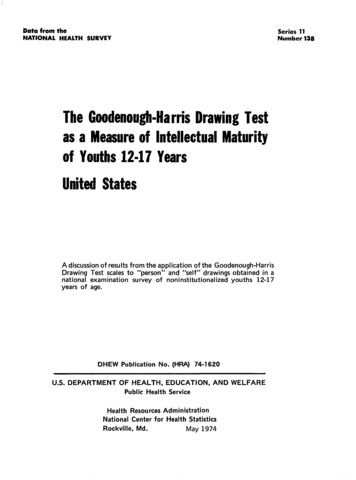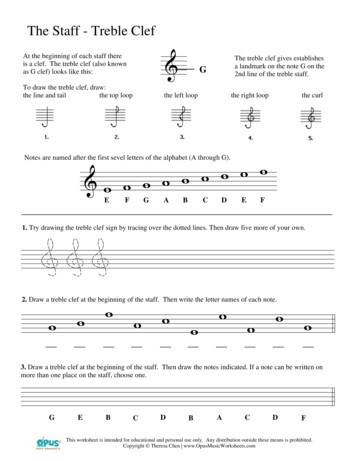
Transcription
THE GOODENOUGH DRAW-A-MAN TESTAS A MEASURE OF INTERPERSONAL ADJUSTMENTAPPROVED:Minor Professor'Dean of the School dfc Ed&6ationDean of the Graduate School
THE GOODENOUGH DRAW-A-MAN TESTAS A MEASURE OF INTERPERSONAL ADJUSTMENTTHESISPresented to the Graduate Council of theNorth Texas State University in PartialFulfillment of the RequirementsFor the Degree ofMASTER OF SCIENCEByCharles D. Schloss, B. S.Denton, TexasJanuary, 1969
TABLE OF CONTENTSPageLIST OF TABLESivChapterI.II.III.IV.V.INTRODUCTION. . . . . .1RESEARCH METHODS14RESULTS18DISCUSSION OF RESULTS24SUMMARY AND CONCLUSIONS36APPENDIX39BIBLIOGRAPHY47lii 1
LIST OF TABLESTableI.II.III.IV.PageCorrelating of DAM Scores and DCB Factors . . . .18Means and Standard Deviations of DCB FactorScores for Each of Three DAM AbilityGroups20Summary of Simple Analyses of Variance21Intercorrelations of DCB Factors22IV
CHAPTER IINTRODUCTIONTheoretical BackgroundThe requirements for the effective functioning of thehuman organism within the context of a given culture aremany and varied.One provision, obviously, is adequate ad-justment to the mores, social requirements, and interpersonalmodes of behavior dictated by that culture.With this fac-tor in mind, the evaluation of personality adjustment becomesan important element in examining the degree to which newmembers of a society are being introduced to the ways of theculture.Among the plethora of techniques designated to assesscertain aspects of an individual adjustment to a given culture is the Goodenough Draw-A-Man Test of IntellectualMaturity (DAM), developed in 1926 by Florence L. Goodenough,and revised in 1963 by Dale B. Harris.The initial purposeof the test was to provide an easily scored, relatively culture free measure of the intellectual functioning of the preadolescent child (6).Subsequent research has indicated that# it serves this purpose well (See "Related Research," p. 8.).But, a second use of the test was suggested by Goodenough:the use of the DAM as a measure of personality adjustment.i
Goodenough originally stated:It is not impossible that a type of performance whichis so closely related to the mental life of the individual as is spontaneous drawing, may sometimes revealmuch instability before it has manifested itself to anymarked degree in everyday behavior (5, p. 62) .Since this statement was made, the test has in factdeveloped into a valuable tool for the detection and diagnosis of behavior disorders and individual maladjustment inchildren.Several other tests have been developed and vali-dated on the theoretical basis of Goodenough's originaleffort.The guidelines of the test, as set forth by Good-enough and later revised by Harris, also seem to indicatethe possibility of analyzing personal adjustment with theDAM.The core assumption of the test follows:The child's drawing of an object will reveal the discriminations he has made about that object as a concept.This concept, when expressed, becomes a useful indexto the complexity of his concepts in general (6, p. 7).Concept formation, according to Harris, is composed of*three elemental factors:1.2.3.The ability to Perceive, i.e., to discriminate likenesses.The ability to Abstract to a new situation thesediscriminations.The ability to Generalize from a given context to anew context (6, p. 5).Each of these statements seem to indicate that the childmust accurately perceive his environment in order to be considered adequately adjusted and, concomitantly, to performwell on the DAM.
At this point, it would seem necessary to suggest aworking definition for the term "adjustment."For this de-lineation, Leary's theory of interpersonal behavior, asderived from Sullivan, Horney, Fromm and others, providesvaluable enlightenment.Rather than assess a degree orquality of adjustment on the basis of some internal or personal criterion, Leary chooses another measure.He statesthat any deviation from the norm must be viewed in terms ofthe social context in which the individual is adjusted.Hence, factors of adjustment and maladjustment are evaluatedin the following manner:Adjustment in terms of the over-all personality organization consists of flexible, balanced, appropriate,accurate interpersonal behavior. In terms of the subdivisions of personality—the levels of public interaction, perception and private symbolism—it consistsof appropriate, accurate and balanced interpersonalbehavior respectively (9, p. 31).Leary, then defines adjustment in terms ofaction between individuals.noted.effert-.-i v pin-h( »r-But, one vital point must beAccording to this theory, "it is important to notethat interpersonal behavior refers to private perceptions,conscious reports, symbolic and unwitting expressions, aswell as to overt actions" (9, p. 9).In this way Leary en-compasses the individual behavior exhibited, for example, by .the schizophrenic child who is unable to form a complex "bodyimage" concept.The child's perception of interpersonal re-lationships is so distorted as to make him unable toaccurately complete the abstraction and generalization1
necessary to successful performance on a measure such asthe DAM.This example suggests a relationship between Leary'sdefinition of adjustment and DAM performance.The "subdi-visions of personality" that Leary sets forth—publicinteraction, perception and private symbolism—are almostexactly analogous to those elements Harris considers vitalto successful performance on the DAM.Leary's "perceptionof interpersonal data" is the counterpart of Harris' "abilityto perceive."Leary's "public interaction" can be likenedto Harris' "ability to generalize from a given context toanother situation."Leary's "private symbolism" equates toHarris' "ability to abstract."Following the equation ofeach theorist's three basic processes, logical progressionseems to indicate that if the premises of the system are related, then the conclusions should also be related.Hence,a relationship between performance on the DAM test and socialadjustment/maladjustment becomes tenable in light of Leary'sdefinition of social variables.In order to measure the extent of this supposed relationship, it is necessary to select a relevant criterionmeasure of social adjustment.Fortunately, there exists aninstrument that is readily adaptable to this use, and infact encompasses some aspects of the relationships justdescribed.The Devereux Child Behavior Rating Scale (DCB)was developed in 1964 with the expressed purpose being tot
. reliably describe the patterns of symptomatic behaviors as observed in 'real life' situations" (5, p. 1).The scale " . . . provides a means whereby an individual whohas intimate living contact with the child can reliably describe and communicate to others regarding overt symptomaticbehavior" (5, p. 3).According to the manual, the scale isconsidered by the authors to be a reliable behavior criterion for use as a research tool (15, p. 3).The DCB measures seventeen behavior factors which coversuch areas as basic self-care, control of body processes,attentive power, need for independent mastery, and areasrelated to social functioning that are basic to the establishment of effective reality contacts and meaningful interpersonal relationships.Of these seventeen factors, fiveare dominant in their measurement of interpersonal behavior.These factors and their descriptions follow:1.Social Isolation*This factor taps the extent to which the youngster issocially "in contact" with his peers.The factor being mea-sured combines social fearfulness and avoidance with thetendency to be rejected by peers.Youngsters with moderateretardation (around IQ 70) tend to show more social isolationthan those with less or more intellectual efficiency (15, p. 10).2.Inadequate Need for IndependenceFactor scores measure the extent to which a child failst6 show the usual signs of striving for autonomy.!Inadequate
need for independence is greater in lower IQ youngsters.Certain youngsters diagnosed as schizophrenic obtain higherscores on this factor, possibly reflecting their inadequatelydeveloped sense of "self" (15, p. 13).3.Need for Adult ContactThis factor taps the tendency to approach adults, implying an emotional need for adult contacts, relationships,and/or approval.Many children with the clinical diagnosisof schizophrenia or personality disorder obtain lower scoresdue to their exaggerated social distance (15, p. 16).4.Social AggressionItems in this factor combine the elements of aggressiveintent and peer relations.While the aggressive aspect ismore clearly in evidence, the social aspect must not beunderestimated.Over a broad IQ spectrum, high scores tendto occur in children who show other signs of social relatedness.Among severely retarded children, factor scores arerelated to the efficiency of communication with others andmaturity of language development, both of which increase associal relatedness to adults increases (15, p. 19).5.Unethical BehaviorThe four items in this factor are unambiguous in theirsuggestion of an absence of internalized codes of ethicalsocial conduct.Scores are positively related with IQ acrossa broad range of IQ.The suggestion is that high scores onthis factor do not stem from an inability to understandt
intellectually, that such behavior is frowned upon, butrather from a deficient learning or "introjection" of certain"moral" codes of conduct while growing up.(It should benoted that this factor was chosen because it was felt thatfailure to internalize cultural norms indicated a failurein the socialization process resulting largely from faultyinterpersonal and social relationships (15, p. 17). )To summarize, then, the DAM measures the level of intellectual functioning of pre-adolescent children by samplingthe child's ability to perceive a concept, the ability to abstract from that concept, and the ability to generalize thatabstraction to another context.Leary's definition of ad-justment in terms of the totality of personality componentsrequires effective interpersonal functioning at the subdivisions of personality that he defines as public interaction,perception, and private symbolism.These terms are, as noted,to some degree analogous to Harris' three vital elements, andindicate that some relationship might exist between the twomeasures. A third indicator of the relationship between intellectual function and social adjustment, and the chosencriterion measure, is the DCB rating scale, which developsseveral factors of interpersonal and social behavior.Hence,the course of this investigation is indicated.The ProblemSince the premises and history of the DAM seem to indicate a relationship between this technique and adjustment/i
8maladjustment, and since Leary defines maladjustment in termsof interpersonal behavior, the problem to be studied is toattempt to quantitatively relate DAM scores with some objective measure of social adjustment or maladjustment inchildren.The criterion chosen for this purpose is the DCBrating scale.The hypothesis, then, follows:There will be a significant positive correlation betweenchildren's performance on the Goodenough Draw-A-Man Test andquality of social and interpersonal adjustment as measuredby selected forms of the Devereux Child Behavior RatingScale.Related ResearchThe justification of the Goodenough Draw-A-Man Test asa valid measure is extensive.In addition to the presen-tations made by Goodenough (who found a .74 W/SB) (5) andHarris (6), much independent research has solidly establishedthe DAM as an easily scored, relatively culture-free measureof intellectual efficiency.Kennedy and Lindner (8) found a.67 correlation between the DAM and the Stanford-Binet formLM.Carkhuff (2) found an r between the DAM and the WAISFull Scale of .74, with r's between scorings of .93, .93, and.92 for the three judges.Vane and Kessler (19) found testretest reliability ranging from .60 to .80, as well as correlations with the Stanford-Binet ranging from .53 to .58.Their summary was that the DAM was indeed a reasonably effective, quickly scored measure of intelligence in children.i
In order to determine the degree of freedom from cultural influence of the DAM, Thomas and Sjab (17) administeredthe test to a group of Indonesian children and found that. .the DAM yields sufficiently promising results to warrant its use as a measure of ability for Indonesian children"(p. 234).Kennedy and Lindner (8), in a normative studywith 1500 Negro elementary school children also found themeasure to be effective.Hence, the claim of the DAM to berelatively culture-free would seem to be justified.As a technique for the evaluation of personality, theDAM has a strong theoretical and empirical background.TheReichenberg-Hackett Study (1953) showed that experimentallyinduced, positively toned emotional states influenced children toward improved drawing performance.Una (20) testeda group of Israeli children and concluded that "childrendescribe the perception of their external world in theirdrawings" (p. 495).This would suggest that some aspect ofthe individual's "mental set" is incorporated in the drawingprocess.If this is true, then pathology would be detect-able through analysis of the drawings.In support of. thistheory, Kahn and Jones (7) had prospective admissions to amental institution draw a figure prior to any other examination.Correlation of the analysis of the figure to the com-plete mental examination led to the conclusion that the drawingwas indeed a good screening device for the judgment of pathology.Lewinsohn (10) also found a direct relationship between the1
10height of a figure drawing and the degree of depression evidenced by a group of mental patients, with significanceextended to the .01 level of confidence.Several researchers have used the DAM test itself tomeasure pathology.Des Lauriers and Halper (4), for example,found lower IQ scores in schizophrenic children with theDAM than with another standard measure of intellectualfunctioning.This was attributed theoretically to the psy-chotic child's body image disturbance which results fromfaulty perception of both himself and others.Bender (1)used the DAM with a small sample of children suffering frompost-encephalitic behavior disorders and found that the DAMIQ was much inferior to scores on the Stanford-Binet.Shehypothesized that the cerebral damage caused by the disorderhad resulted in considerable impairment to the perceptualprocesses necessary to accurately form a meaningful "bodyconcept" whole.Chase (3) noted small DAM differences be-tween paranoids and normals after matching IQ on the StanfordBinet.Again, this difference was attributed to a failureto accurately perceive self or other body image.More recently, Vane and Eisen (18) attempted to determine the sensitivity of the DAM to the school adjustment of662 kindergarten children.ratings of adjustment.The criterion was teacher'sIt was found that at least four DAM;S'signs proved to be significant in the identification of thosechildren deemed to be suffering from maladjustment.i.Richey
11and Spotts (13) found a direct relationship between the drawing of a figure and the popularity of the child, indicatingto some extent a relationship between the principles andpremises of the DAM and pathology of interpersonal adjustment.It follows from this research that the Goodenough, inaddition to serving its original purpose, shows promise asa measure of personality adjustment.This assumption isprobably most soundly supported by Machover's (11) extensivetreatment of the subject.There is, however, little researchinto the interpersonal implications of the pathological behavior detected by the DAM and related techniques, since mostof the above studies tend to mention behavior limited to theevaluation of intra-personal disorder.The related research associated with the Devereux ChildBehavior Rating Scale originates with the development of thescale by Spivak and Levine.It stems from research orientedtoward providing "a reliable and quantitative system of symptom description to provide the basis for a more useful diagnostic nomenclature" (14, p. 3).In a further investigation,Spivak and Spotts (16) factor analyzed 121 behavioral symptoms to produce a series of first- and second-order factors.These factors were investigated and developed into the DCBscale, which was published in 1966 (15).The manual outlines(without reference) further validating research, and normative data.It is vital to note that a rater reliability of.77 to .83 was found, insuring, to some extent, the validityof the ratings.i
CHAPTER BIBLIOGRAPHY1.Bender, Lauretta, "The Drawing of a Man in ChronicEncephalitis in Children," Journal of Nervous andMental Disorders, VIL (1940), 277-286.2.Carkhuff, R. B., "The Goodenough Draw-A-Man Test as aMeasure of Intelligence in NoninstitutionalizedSubnormal Adults," Journal of Consulting Psychology,XXVL (1962), 476-484.3.Chase, Jane M., "A Study of the Drawings of a Male FigureMade by Schizophrenic Patients and Normal Subjects,"Character and Personality, IX (1941), 208-217./A.Des Lauriers, A. and F. Halper, "Psychological Tests inChildhood Schizophrenia," American Journal of Orthopsychiatry, XVII (1947), 57-67.v/5.Goodenough, Florence L., Measurement of Intelligence byDrawings, New York, Harcourt, Brace and World, 1926./6.Harris, D. B., Children's Drawings as Measures of Intellectual Maturity, New York, Harcourt, Brace and World,1963.7.Kahn, Marvin and N. F. Jones, "Human Figure Drawings asPredictors of Admission to a Psychiatric Hospital,"Journal of Projective Techniques and PersonalityAssessment, IXXX (1965), 319-332.Kennedy, W. A. and R. S. Lindner, "A Normative Study onthe Goodenough Draw-A-Man Test on Southeastern Elementary School Children," Child Development, XXXV(1964), 33-62.Leary, Timothy, Interpersonal Diagnosis of Personality,New York, The Ronald Press, 1957.vy 0.Lewinsohn, Peter M., "The Relationship Between Height ofFigure Drawing and Depression in Psychiatric Patients,"Journal of Consulting Psychology, XXVIII (1964), 380381.11.Machover, Karen, Personality Projection in the Drawing ofthe Human Figure, Springfield, Charles C. Thomas, 1949.12
1312.Reichenberg-Hackett, W., "Changes in Goodenough DrawingsAfter-a Gratifying Experience," American Journal ofOrthopsychiatry, XXIII (1953), 501-517.13.Richer, M. J. and J. V. Spotts, "Relationship of Popularity to Performance on the Goodenough Draw-A-ManTest," Journal of Consulting Psychology, LI (1961),10-14.14.Spivak, G. and M. Levine, "The Devereux Child BehaviorRating Scale: A Study of Symptom Behavior in LatencyAge Atypical Children," American Journal of MentalDeficiency, LXVII (1965), 839-853.Jk.5. Spivak, G. and J. Spotts, The Devereux Child BehaviorRating Scale Manual, Devon, Penn., The Devereux Foundation, 1966.16.Spivak, G. and J. Spotts, "The Devereux Child BehaviorScale: Symptom Behaviors in Latency Age Children,"American Journal of Mental Deficiency, LXIX (1965),839-853.Thomas, R. M. and A. Sjab, "The Goodenough Draw-A-ManTest in Indonesia," Journal of Educational Psychology,LII (1961), 232-235.18.Vane, J. R. and V. W. Eisen, "The Goodenough Draw-A-ManTest and Signs of Maladjustment in Kindergarten Children," Journal of Clinical Psychology, XVIII (1962),276-279.19.Vane, J. R. and R. T. Kessler, "The Goodenough Draw-AMan Test: Long Term Reliability and Validity," Journal of Clinical Psychology, XX (1964), 487-488.20.Una, Berurit, "Hapeniza Lateur Harealis," Urim XXI(1964/1964), 493-495.
CHAPTER IIRESEARCH METHODSSubjectsThe subjects chosen for this experiment were 47 preschool children enrolled in a private kindergarten in Denton,Texas.Some upward skewing of the DAM scores was expecteddue to the limited nature of this sample, but this problemdid not, however, materialize, as will be demonstrated.Thechildren ranged in age from four to seven years of age.Thesubjects were divided into four classes by the kindergarten,and this division was not disturbed.InstrumentsThe measures chosen for this investigation were, as previously described, the Goodenough Draw-A-Man Test of Intellectual Maturity, and the five selected factors of theDevereux Child Behavior Rating Scale.The DCB factors areintended to be statistically independent of one another.Hence, no harm to the validity of the scale is done by extraction of isolated factors.The DCB was scored accordingto the instructions outlined in the manual (2).The Harris revision of Goodenough's original scoringmethodology (1) was selected because of its greater refinement and more explicit instructions, as well as the provisioni14
15of more extensive and recent normative data.Harris' entiretest revision was not employed because of a lack of independent verification data concerning the modification to Goodenough's original technique.ProcedurePrior to administration of the- DAM test, a condensedset of instructions for administration was given to theteachers involved (See appendix).Since the DAM was to beadministered by each child's teacher in the class setting,the teachers were briefed concerning the purpose of the test,directed to read the instructions, and counseled concerningany questions or misunderstandings.The DAM was then admin-istered as part of the normal classroom activity.All ofthe standardized procedures set forth by Harris were rigidlyfollowed, with only the exception previously noted.Eachchild was given paper and pencil identical to that of hisneighbors, and no individual attention was given except asprovided for in Harris' manual.Following completion of the test, three independentscorers (the investigator and two trained assistants) evaluated the tests according to Harris' guidelines.In order toassure objectivity of rating, each test was scored threetimes, once by each independent judge.In order to evaluatethe objectivity of the scoring process, a rank-order correlation was computed between the three raters.Results of
16the intercorrelations showed coefficients of .87, .90, and.91 between all possible combinations of judges.The revised DCB rating forms were then distributed tothe teachers and instructions given.The teachers were en-couraged to take all the time they wished in order to completethe forms, thereby assuring studied attention to rating.lowing the collection of the rating scales, the variousfactor scores were compiled.Fol-
CHAPTER BIBLIOGRAPHY1.Harris, D. B., Children's Drawings as Measures of Intellectual Maturity, New York, Harcourt, Brace and World,1963.2.Spivak, G. and J. Spotts, Devereux Child Behavior RatingScale Manual, Devon, Penn., The Devereux Foundation,1966.17
CHAPTER IIIRESULTSThe results derived from the procedures outlined inChapter II were examined statistically in order to provide abasis for acceptance or rejection of the major hypothesis.The main part of this examination involved Pearson productmoment correlations between intelligence as measured by theDAM, and the several selected DCB factors.These corre-*lations are summarized in Table I, with significance determined by attainment of the .05 level of confidence.TABLE ICORRELATIONS OF DAM SCORES AND DCB FACTORSDCB FactorSocial IsolationInadequate Need forIndependenceNeed for Adult ContactCorrelationwith DAM ScoresSignificance-.1731N.S.-.1218N.S. .1175N.S.Social Aggression-.1642N.S.Unethical Behavior-.0242N.S.The results presented in this table indicate that noneof the five DCB factors correlated to a significant degreewith DAM IQ since an r of .288 was necessary to produce18I
19significance.It will be noted, however, that four of thefive correlations were in a negative direction, that is,in the hypothesized direction.The highest correlation pro-duced was between DAM IQ and DCB factor Social Isolation(-.1731).Since the basic correlation of factors failed to produce statistically significant relationships between thevariables, another technique, not directly related to themajor hypothesis, was attempted.The Ss, with a total DAMscore range from approximately 62 to 137, a mean of 92.65and a standard deviation of 15.74, were divided into threegroups on the basis of ability as represented by DAM scores.These groups and their limits follow:Group I:Lowest 25 per cent (62-82)Group II:Middle 50 per cent (85-96)Group III:Highest 25 per cent (101-137)Next, the mean DCB factor scores were computed for each ofthe three DAM ability groups.This technique is employedin order to attempt to discern any potentially meaningfulindications of trends, whether or not these trends approacha degree delineated statistically significant.The DCBmeans and standard deviations are presented in Table II.
20TABLE IIMEANS AND STANDARD DEVIATIONS OF DCB FACTOR SCORESFOR EACH OF THREE DAM ABILITY GROUPSDCB FactorSocial IsolationInadequate Needfor IndependenceNeed for D.M.7.3076 3.9102MiddleM.S.D.5.4166 3.0127HighM.S.D.4.8000 2.181713.3076 1.4349 13.1250 1.9856 11.9000 1.81389.3846 3.40908.7083 2.7760 11.0000 3.577714.3846 5.0052 14.5000 4.8045 12.5000 3.10647.0769 2.01766.0833 2.36147.0000 2.7202Examination of this table in order to discover ascendingor descending trends in means of the DAM groups shows DCBSocial Isolation to be related linearly with DAM ability,although not to a significant statistical degree.This samefactor, as previously noted, also bears the highest level ofcorrelation.Following this computation, a simple analysis of variancewas computed to test the significance of the differencesamong the three sample means for each DCB factor separately.This procedure generated five analyses of variance summarytables which are presented as a composite in Table III.
21TABLE IIISUMMARY OF SIMPLE ANALYSES OF VARIANCESource1.2.Sum nCode:1".2.3.4.5.,Social IsolationInadequate Need for independenceNeed for Adult ContactSocial AggressionUnethical Behavior1.7575.6841.9163
22Again, there was no evidence of significant relationships,although the highest level of interaction appears on DCBSocial Isolation, indicating that perhaps this factor bearsthe greatest relationship to DAM IQ.Although in no way involved with the major hypothesis,a third operation was integrated into the examination ofdata.This process involved correlation of the interfactorrelationships of the DCB scale.in Table IV.These results are presentedSignificance is again achieved by attainmentto the .288 level, and is noted by an asterisk (*) .TABLE IVINTERCORRELATIONS OF DCB FACTORSInadequateNeed forIndependenceSocialIsolation.0453InadequateNeed forIndependence Need 1875.0792.1750-.1292.0799-.0552*Need forAdultContact" SocialAggression * * .4309* .7075*.4359*
23In this case it will be noted that three factors arecorrelated to a significant degree, namely Need for AdultContact and Social Aggression? Need for Adult Contact andUnethical Behavior; and Social Aggression and UnethicalBehavior.This finding suggests that, in this populationat least, the DCB factors are not entirely homogeneous.
CHAPTER IVDISCUSSION OF RESULTSResults Relating to Major HypothesisIn any investigation, there are two basic areas whereinerror may foil the affirmation of the hypothesis.Initialfailure of theory, encompassing analysis of previous researchand deduction from the premises thereby derived, can lead tothe statement of a hypothesis which is inherently inaccurate.Thus, the results of an accurately conducted test of thehypothesis will prove the statement incorrect.Conversely, a hypothesis properly researched and formulated and based on sound theory, can be rejected because offaulty technique in administration.This broad heading in-cludes the use (or misuse) of improper measures, that is,not measuring what should be measured in order to adequatelytest the hypothesis.Secondly, the population sample may notbe appropriate for the problem to be investigated.Thirdly,improper administration of the investigation must be included;that is, admission of extraneous variables or commission ofadministrative errors which lead to the confounding ofresults.A review of the results presented in Chapter III indicates that the working hypothesis of this investigation24:
25was not affirmed; that the previously stated level of significance was not reached by any of the necessary combinationsof factor scores. Hence, the hypothesis, that there wouldbe a significant positive correlation between children'sperformance on the Goodenough Draw-A-Man Test and quality ofsocial and interpersonal adjustment as measured by selectedfactors on the Devereux Child Behavior Rating Scale, must berejected.It is the purpose of this discussion to attemptto speculate as to possible reasons for the results as wellas to indicate areas which might warrant further research.As stated, none of the correlations between the five DCBfactors and DAM scores from the total population proved significant.The highest correlation, as well as the highestdegree of interpretation (keeping in mind that negative correlation is compatible with the hypothesis, since the DCBfactor's scores should vary inversely with DAM score) is exhibited between factor two, Social Isolation, and DAM IQ.This level is approached by factor five, Social Aggression.These seemingly disparate indications may be reconciled tosome degree by returning to the DCB Manual's description ofthe factors.The DCB Manual states that Social Isolation scores tendto be highest in .'.'.children who communicate poorly and showpoor language development" (5, p. 11).By the same token,Social Aggression is "related to the efficiency of communica
The justification of the Goodenough Draw-A-Man Test as a valid measure is extensive. In addition to the presen-tations made by Goodenough (who found a .74 W/SB) (5) and Harris (6), much independent research has solidly established the DAM as an easily scored, relatively culture-free measure of intellectual efficiency. Kennedy and Lindner (8 .










